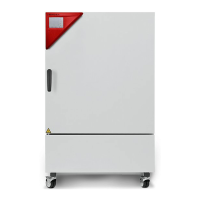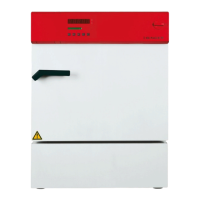Do you have a question about the Binder KB and is the answer not in the manual?
Defines requirements for personnel operating the chamber.
Guide for proper use, storage, and reference.
Information on intellectual property and manual usage terms.
Defines DANGER, WARNING, CAUTION, NOTICE levels.
Symbol indicating risk of injury, requires caution.
Displays warning, mandatory, and prohibition signs with meanings.
Illustrates and labels the main components of the cooling incubator.
Describes the instrument panel, controller display, and buttons.
Details the lateral control panel for specific models, including power switch and ports.
Illustrates and labels connections and options on the chamber rear.
Instructions for unpacking, checking contents, and handling delivery damage.
Provides guidelines for safely lifting, moving, and transporting the chamber.
Specifies conditions and precautions for storing the chamber.
Explains the use and mounting of spacers for maintaining wall distance.
Details how to mount the tilt protection kit for safety.
Explains the controller's menu system and navigation buttons.
Lists functions accessible via the general menu, including settings and data transfer.
Describes accessing frequently used functions via the quick menu.
Explains the user menu, including key lock and event list access.
Provides step-by-step instructions for switching between operating modes.
Explains how to switch zero-voltage relay control outputs on or off.
Describes how to test the optional alarm output functionality.
Explains how to enable or disable the object temperature display.
Specifies the valid ranges for temperature and fan speed set-points.
Step-by-step guide to entering set-points using the quick menu.
Detailed steps for setting the temperature set-point via the quick menu.
Detailed steps for setting the fan speed set-point via the quick menu.
Step-by-step guide to creating a new time program.
Explains how to insert, copy, paste, and delete program sections.
Details how to set the temperature for a specific program section.
Details how to set the duration for a specific program section.
Explains how to set section repetitions for cyclical programs.
How to define tolerance ranges for program sections.
Explains the 'ramp' and 'step' modes for temperature transitions.
How to enable/disable relay outputs for specific program sections.
Steps to save a time program and exit the editor.
Detailed instructions for starting an existing week program.
Instructions for stopping a running week program.
Step-by-step guide to creating a new week program.
Explains how to insert, copy, paste, and delete program sections for week programs.
Details how to set the temperature for a specific week program section.
Details how to assign days of the week to a program section.
Details how to set the time for a specific week program section.
How to set the activity status (active/inactive) for shift points.
How to enable/disable relay outputs for specific week program sections.
Guides on selecting parameters like temperature and fan speed for week programs.
Steps to save a week program and exit the editor.
How to activate the key lock function immediately.
How to configure automatic key lock activation based on inactivity.
Guides through initial chamber configuration via a setup wizard.
Instructions for setting the current date and time on the controller.
How to select the desired menu language for the controller display.
Instructions for adjusting the brightness of the controller display.
How to select the preferred unit for temperature display.
How to define the interval for data recording to the SD card.
How to view the chamber's MAC address for network identification.
Steps for entering or verifying the chamber's IP address.
Steps for entering or verifying the chamber's subnet mask.
How to set a custom name for the chamber.
How to set the network name for the chamber.
How to configure gateway and DNS server addresses.
Detailed steps for exporting chamber data (status, values, programs) to a USB drive.
Detailed steps for importing data (programs, configuration) from a USB drive.
Explains various icons and their meanings related to operating modes.
Lists different alarm messages and their significations.
Describes the three states of alarm messages: set, acknowledged, cleared.
Step-by-step guide to acknowledging and resetting active alarms.
Accesses alarm lists and configuration options like buzzer and alarm functions.
Displays a list of all currently active alarms.
Shows a list of all triggered and cleared alarms, including dates.
How to test, activate, or deactivate the alarm buzzer.
How to activate or deactivate all alarm functions on the controller.
How to set the interval for data sampling in the graphical display.
How to set minimum and maximum values for the graphical display.
How to select which parameters to display graphically.
Describes the primary over-temperature protection device.
Details the class 3.1 overtemperature safety controller.
Explains 'Limit' and 'Offset' modes for the safety controller.
Steps to set the mode and set-point for the safety controller.
Explains 'Limit' and 'Offset' modes for the class 3.3 safety controller.
Steps to set the mode and set-points for the class 3.3 controller.
Describes the optional APT-COM™ software for chamber control.
Details the optional data logger kit for temperature measurement and recording.
How the interior lighting operates when the door is opened/closed.
Explains the optional alarm output for transmitting alarms externally.
Describes optional relay control outputs for switching external devices.
How to use the Pt100 sensor to display object temperature.
Outlines safe cleaning methods and recommended agents.
Specifies qualifications needed for maintenance and service personnel.
Information on required maintenance intervals and service procedures.
Provides a table for diagnosing and resolving common chamber faults.
Guidelines for disposing of packaging materials responsibly.
Steps for safely decommissioning the chamber before disposal.
Details legal requirements for disposing of the chamber in Germany (WEEE).
Details legal requirements for disposal in EU countries (WEEE).
Guidance on disposal in non-EU countries, emphasizing local regulations.
Information on factory calibration and recommended recalibration intervals.
Describes the over-current protection features and fuse replacement.
Explains how the usable volume is calculated and provides usage guidelines.
Presents the EU Declaration of Conformity for the chambers.
Instructions and form for clearing contamination for units outside USA and Canada.
Defines requirements for personnel operating the chamber.
Guide for proper use, storage, and reference.
Information on intellectual property and manual usage terms.
Defines DANGER, WARNING, CAUTION, NOTICE levels.
Symbol indicating risk of injury, requires caution.
Displays warning, mandatory, and prohibition signs with meanings.
Illustrates and labels the main components of the cooling incubator.
Describes the instrument panel, controller display, and buttons.
Details the lateral control panel for specific models, including power switch and ports.
Illustrates and labels connections and options on the chamber rear.
Instructions for unpacking, checking contents, and handling delivery damage.
Provides guidelines for safely lifting, moving, and transporting the chamber.
Specifies conditions and precautions for storing the chamber.
Explains the use and mounting of spacers for maintaining wall distance.
Details how to mount the tilt protection kit for safety.
Explains the controller's menu system and navigation buttons.
Lists functions accessible via the general menu, including settings and data transfer.
Describes accessing frequently used functions via the quick menu.
Explains the user menu, including key lock and event list access.
Provides step-by-step instructions for switching between operating modes.
Explains how to switch zero-voltage relay control outputs on or off.
Describes how to test the optional alarm output functionality.
Explains how to enable or disable the object temperature display.
Specifies the valid ranges for temperature and fan speed set-points.
Step-by-step guide to entering set-points using the quick menu.
Detailed steps for setting the temperature set-point via the quick menu.
Detailed steps for setting the fan speed set-point via the quick menu.
Step-by-step guide to creating a new time program.
Explains how to insert, copy, paste, and delete program sections.
Details how to set the temperature for a specific program section.
Details how to set the duration for a specific program section.
Explains how to set section repetitions for cyclical programs.
How to define tolerance ranges for program sections.
Explains the 'ramp' and 'step' modes for temperature transitions.
How to enable/disable relay outputs for specific program sections.
Steps to save a time program and exit the editor.
Detailed instructions for starting an existing week program.
Instructions for stopping a running week program.
Step-by-step guide to creating a new week program.
Explains how to insert, copy, paste, and delete program sections for week programs.
Details how to set the temperature for a specific week program section.
Details how to assign days of the week to a program section.
Details how to set the time for a specific week program section.
How to set the activity status (active/inactive) for shift points.
How to enable/disable relay outputs for specific week program sections.
Guides on selecting parameters like temperature and fan speed for week programs.
Steps to save a week program and exit the editor.
How to activate the key lock function immediately.
How to configure automatic key lock activation based on inactivity.
Guides through initial chamber configuration via a setup wizard.
Instructions for setting the current date and time on the controller.
How to select the desired menu language for the controller display.
Instructions for adjusting the brightness of the controller display.
How to select the preferred unit for temperature display.
How to define the interval for data recording to the SD card.
How to view the chamber's MAC address for network identification.
Steps for entering or verifying the chamber's IP address.
Steps for entering or verifying the chamber's subnet mask.
How to set a custom name for the chamber.
How to set the network name for the chamber.
How to configure gateway and DNS server addresses.
Detailed steps for exporting chamber data (status, values, programs) to a USB drive.
Detailed steps for importing data (programs, configuration) from a USB drive.
Explains various icons and their meanings related to operating modes.
Lists different alarm messages and their significations.
Describes the three states of alarm messages: set, acknowledged, cleared.
Step-by-step guide to acknowledging and resetting active alarms.
Accesses alarm lists and configuration options like buzzer and alarm functions.
Displays a list of all currently active alarms.
Shows a list of all triggered and cleared alarms, including dates.
How to test, activate, or deactivate the alarm buzzer.
How to activate or deactivate all alarm functions on the controller.
How to set the interval for data sampling in the graphical display.
How to set minimum and maximum values for the graphical display.
How to select which parameters to display graphically.
Describes the primary over-temperature protection device.
Details the class 3.1 overtemperature safety controller.
Explains 'Limit' and 'Offset' modes for the safety controller.
Steps to set the mode and set-point for the safety controller.
Explains 'Limit' and 'Offset' modes for the class 3.3 safety controller.
Steps to set the mode and set-points for the class 3.3 controller.
Describes the optional APT-COM™ software for chamber control.
Details the optional data logger kit for temperature measurement and recording.
How the interior lighting operates when the door is opened/closed.
Explains the optional alarm output for transmitting alarms externally.
Describes optional relay control outputs for switching external devices.
How to use the Pt100 sensor to display object temperature.
Outlines safe cleaning methods and recommended agents.
Specifies qualifications needed for maintenance and service personnel.
Information on required maintenance intervals and service procedures.
Provides a table for diagnosing and resolving common chamber faults.
Guidelines for disposing of packaging materials responsibly.
Steps for safely decommissioning the chamber before disposal.
Details legal requirements for disposing of the chamber in Germany (WEEE).
Details legal requirements for disposal in EU countries (WEEE).
Guidance on disposal in non-EU countries, emphasizing local regulations.
Information on factory calibration and recommended recalibration intervals.
Describes the over-current protection features and fuse replacement.
Explains how the usable volume is calculated and provides usage guidelines.
Presents the EU Declaration of Conformity for the chambers.
Instructions and form for clearing contamination for units outside USA and Canada.
| Brand | Binder |
|---|---|
| Model | KB |
| Category | Accessories |
| Language | English |


